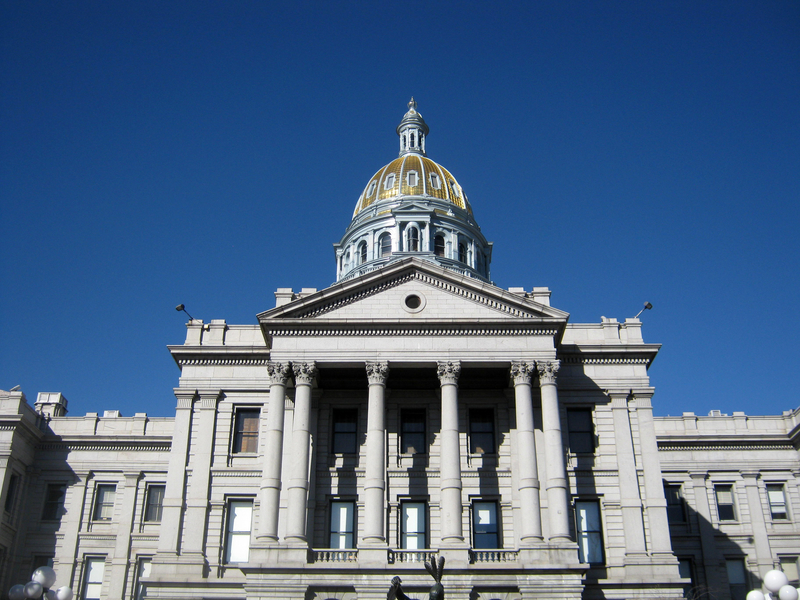A Post-Pandemic Return to Normal for Legislators?
With the state in the grip of the Omicron surge of COVID-19 the 2022 legislative session is set to begin Wednesday, Jan. 12 and run through early May. How long things can be in person may remain to be seen.
Legislative leaders say the plan is to start on time, and to try to get as much work done as soon as possible, before the next shoe drops — if it does. Here again, the pandemic will be calling the shots; determining not just how the session will be run, but likely impacting the legislation that will be introduced.

Colorado State Capitol, Image courtesy of Good Free Photos.
It was only 18 months ago that lawmakers slashed the state’s budget by millions as the economic impact of the pandemic was expected to be severe. Then — 2020 was surprisingly robust and this year — as the pandemic continues the economy is booming, tax revenue is rising and the state’s unemployment rate is near a record low. The federal stimulus funds and growing tax revenue mean a projected budget increase of four percent.
The 2022-23 fiscal year state budget is expected to be about $40 billion; a four percent increase from this fiscal year. That is a state record. There are endless possible impacts of the increase but one thing that has not been true for years is this: the legislature will have much more money to work with than it usually does. It can choose to put that money into new or expanded programs, including those that might be created by upcoming legislation.
“In a typical year,” said Joint Budget Committee member and state Sen. Chris Hansen, a Denver Democrat, “we might have $300 million or $400 million of discretionary spending decisions to make. This year we basically have $4 billion.”
Some of the project areas are expected: the state is committed to putting more funding to improve housing affordability for its workforce, for example.
Then, of course, there are the tax refunds. That’s because due to the Taxpayer’s Bill of Rights, or TABOR, (a strange fiscal restraint that only exists in Colorado) when Colorado’s economy is doing well, as it is now, the state is required to refund to taxpayers.
The thing is, the better the economy, the higher the refunds; the state can’t create a rainy-day account to tide us over during the bad years (and rest assured, those years are coming.) In the meantime, state economists say that for the next few years, the refunds are probably going to reach historic highs of about $2 billion in each of the next three years.
Doing the math, that money will be divided out to about $400 in refund checks for single filers depending upon income and higher earners will get larger checks. Any way you look at it, that is a lot of money to give back. Last year, Democrats on the Joint Budget Committee went on record saying that these state monies returned to taxpayers should be adjusted. Both Republicans and probably Governor Polis are expected to disagree with that aspiration. Polis might be a Democrat, but it is an election year, after all.
While the state was reliably purple for several years, in the past decade it turned a Democratic party blue. There is a new state district map this year drawn with the 2020 U.S. census data, which is expected to be more competitive. For the record, all 65 House seats, half the Senate seats, and all four state constitutional offices, among many other jobs, are up for election in November 2022.
Other defining issues:
- Rising crime — The rise in crime across Colorado is fueled not just by massive increases in gun sales, but social unrest and stressors rising from the pandemic and economic uncertainty. The House GOP has indicated their top priority is to see that police have the proper tools they need for enforcement. This includes money to implement prior mandates such as the law passed in a prior session requiring body cameras for all police officers. Also considered important: the resources for mental health co-responder programs.
- Education funding — Colorado has long-standing K-12 and higher education funding challenges as well as new problems driven by the pandemic. Advocates saying it’s past time for the state to make up for years of low funding. There’s also the potential for big investments in job training and changes to how the state shares money with districts. Also likely due for debate is the state’s school accountability system and school ratings during the pandemic. Not to be forgotten, challenges facing Colorado public schools including teacher and bus driver shortages, a growing youth mental health crisis, and lasting impacts of COVID on student learning.
- Abortion rights — Democrats say they plan to bring a bill that would ensure abortions remain legal in the state even if Roe v. Wade is overturned at the U.S. Supreme Court level. Most Republicans, who are in the minority in both houses of the Colorado legislature, are urging a wait-and-see approach based on what the U.S. Supreme Court does. Democrats are forging ahead — and they have the upper hand.








Recent Comments